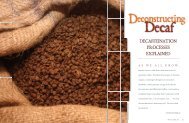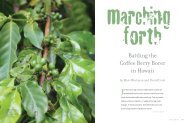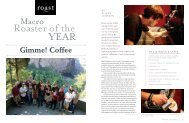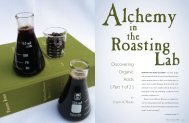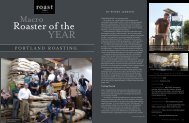Get it Right the First Time - Roast Magazine
Get it Right the First Time - Roast Magazine
Get it Right the First Time - Roast Magazine
You also want an ePaper? Increase the reach of your titles
YUMPU automatically turns print PDFs into web optimized ePapers that Google loves.
R U<br />
L I N<br />
G T<br />
H E<br />
R O A<br />
S T<br />
Ge t It Ri g h t<br />
The <strong>First</strong> <strong>Time</strong><br />
Ho w To Pr e v e n t Ro a s t i n g De f e c t s An d Ta i n t s<br />
BY WILLEM J. BOOT<br />
p h o t o s b y k e n t h a n s o n<br />
I usually teach my students that roasting coffee revolves around <strong>the</strong> simple but important<br />
concept of “roasting right <strong>the</strong> first time.” During <strong>the</strong> coffee roasting process, <strong>the</strong>re are lim<strong>it</strong>ed<br />
opportun<strong>it</strong>ies to correct mistakes. Once <strong>the</strong> beans have cooled, <strong>it</strong> is virtually impossible to reroast<br />
<strong>the</strong>m to a different degree or a different flavor profile. One of <strong>the</strong> keys to producing qual<strong>it</strong>y<br />
coffee is to roast right <strong>the</strong> first time and, in doing so, prevent roasting defects and taints.<br />
continued on page 34<br />
May | June 2004 33<br />
May | June 2004 33
RULING THE ROAST: GET IT RIGHT THE FIRST TIME ( continued)<br />
Common Defects<br />
Picture A.<br />
Panama bean (sliced):<br />
inconsistent bean development w<strong>it</strong>h over-roasting<br />
and under-roasting in <strong>the</strong> same bean<br />
Some major roasting defects occur as a result<br />
of external events, like earthquakes and<br />
power outages. O<strong>the</strong>r defects are <strong>the</strong> result<br />
of operator errors, such as double charging<br />
<strong>the</strong> roasting drum, which occurs when <strong>the</strong><br />
operator accidentally loads a second batch<br />
of green beans into <strong>the</strong> roaster while a first<br />
batch is already being roasted. Such a mistake<br />
can create hours of sorting and selection after<br />
<strong>the</strong> fact. Ano<strong>the</strong>r common operator error is<br />
accidentally over-roasting and burning <strong>the</strong><br />
beans, to <strong>the</strong> extent that even <strong>the</strong> stoutest<br />
operator cannot claim that <strong>it</strong> was a very special<br />
French <strong>Roast</strong>. Some of <strong>the</strong>se errors, such as<br />
earthquakes are obviously not preventable, so<br />
you have to just throw away that batch and<br />
start over.<br />
However, most of <strong>the</strong> aforementioned<br />
errors can be prevented relatively easily. For<br />
example, I would recommend installing a<br />
back-up generator that automatically turns<br />
on in <strong>the</strong> event of a power outage. In this<br />
case, <strong>the</strong> generator can provide emergency<br />
power to <strong>the</strong> drum drive motor and <strong>the</strong> roaster<br />
For service you<br />
can count on,<br />
turn to us.<br />
Call for our free catalog of<br />
cupping supplies, steaming p<strong>it</strong>chers,<br />
<strong>the</strong>rmometers and more.<br />
24-hour shipping available.<br />
www.espressosupply.com<br />
1123 Northwest 51st Street<br />
Seattle, Washington 98107<br />
800.782.6671 • 206.782.6670<br />
Fax 206.789.8221<br />
Free Info #120<br />
34<br />
roast
impellor, which will allow <strong>the</strong> beans to<br />
cool slowly and securely in <strong>the</strong> drum,<br />
thus preventing major heat build-up<br />
and reducing <strong>the</strong> risk of roaster fires.<br />
Fur<strong>the</strong>rmore, developing clear roasting<br />
and operating procedures, as well as<br />
repeating monthly fire and emergency<br />
drills, can help roaster operators respond<br />
quickly and intelligently in case of<br />
unexpected events.<br />
The second category of defects, called<br />
minor defects or roasting taints, occur<br />
when an operator does not calibrate <strong>the</strong><br />
roasting machine adequately for <strong>the</strong><br />
beans being roasted. Although <strong>the</strong>se<br />
defects are not as detrimental to <strong>the</strong><br />
completed cup of coffee, <strong>the</strong>y do occur<br />
more often than operator errors and are<br />
more complicated to correct.<br />
In <strong>the</strong> beginning of my coffee career<br />
in <strong>the</strong> Un<strong>it</strong>ed States, I met a client from<br />
Hawaii who brought me his newest crop<br />
of coffee beans, freshly picked from his<br />
Kona coffee trees. He asked me to design<br />
continued on page 36<br />
Picture B.<br />
Brazil coffee bean:<br />
minor scorch and char marks<br />
Free Info #138 Free Info #115<br />
May | June 2004 35
RULING THE ROAST: GET IT RIGHT THE FIRST TIME ( continued)<br />
Picture C.<br />
Brazil coffee bean:<br />
massive scorching<br />
a roasting profile for his precious beans. In my<br />
first trials, I failed miserably and <strong>the</strong> beans were<br />
scorched on <strong>the</strong> outside and underdeveloped<br />
on <strong>the</strong> inside. The reason was simple: I did<br />
not take <strong>the</strong> proper amount of time to “read”<br />
<strong>the</strong> beans and complete a thorough analysis of<br />
<strong>the</strong>m prior to roasting. Upon investigating <strong>the</strong><br />
coffee, <strong>it</strong> appeared that <strong>the</strong>se freshly produced<br />
Kona beans were relatively high in moisture<br />
and still lacked <strong>the</strong> “settled” cell structure<br />
that occurs when green beans are cured for six<br />
weeks in parchment after <strong>the</strong> completion of<br />
<strong>the</strong> drying process.<br />
As a result of my analysis, <strong>the</strong> next trials<br />
were very successful, and I designed a roasting<br />
profile for my client that addressed <strong>the</strong> higher<br />
moisture content and <strong>the</strong> spongy consistency<br />
of <strong>the</strong> beans. The fresh crop roasting profile in<br />
question allowed my client to maintain a low<br />
roasting temperature during <strong>the</strong> first three to<br />
five minutes (<strong>the</strong> drying phase) followed by<br />
a moderate-heat roasting cycle, resulting in<br />
evenly expanded beans w<strong>it</strong>h consistent color<br />
development inside and outside and no signs<br />
of scorching. In <strong>the</strong> end, I learned my lesson,<br />
and <strong>the</strong> client was happy.<br />
Free Info #127<br />
36<br />
roast
Let’s review some basic parameters that, if<br />
properly analyzed and addressed, can help you<br />
roast right <strong>the</strong> first time, w<strong>it</strong>hout defects.<br />
Bean Moisture<br />
It helps to use an effective moisture analyzer,<br />
which can be purchased for less than $900.<br />
To prevent roasting imperfections, <strong>the</strong> green<br />
bean moisture content should be between 10<br />
and 12.5 percent. Green coffee beans usually<br />
become too dry (8–10 percent moisture) or<br />
too humid (12.5–14 percent) as a result of<br />
improper storage cond<strong>it</strong>ions and environmental<br />
factors. Think of warehouses in regions w<strong>it</strong>h<br />
sub-tropical, humid cond<strong>it</strong>ions or regions<br />
w<strong>it</strong>h bone-dry, hot climates. High-moisture<br />
beans should be roasted very gently in <strong>the</strong> first<br />
stage and low-moisture beans must be watched<br />
closely because of <strong>the</strong> risk of an uncontrollable<br />
acceleration throughout <strong>the</strong> process. I also<br />
recommend recording <strong>the</strong> moisture content of<br />
all green beans frequently.<br />
Picture A. (page 34) shows a Panama bean<br />
continued on page 38<br />
Picture D.<br />
Coffee bean:<br />
first signs of tipping<br />
Free Info #133 Free Info #111 Free Info #134<br />
May | June 2004 37
RULING THE ROAST: GET IT RIGHT THE FIRST TIME ( continued)<br />
w<strong>it</strong>h a low moisture content (8.7 percent), and a roasting process<br />
that was not adequately controlled. Only one minute and 50<br />
seconds passed between <strong>the</strong> beginning of <strong>the</strong> first crack and <strong>the</strong><br />
end of <strong>the</strong> roast (Agtron 55–beans). The picture shows <strong>the</strong> uneven<br />
coloration inside <strong>the</strong> bean where <strong>it</strong> was over-roasted in<br />
some spots and under-roasted in o<strong>the</strong>rs.<br />
full-size batch. If you suspect that <strong>the</strong> beans might be more prone<br />
to scorching, keep <strong>the</strong> charging temperature of <strong>the</strong> roaster as low as<br />
possible, w<strong>it</strong>hout stalling <strong>the</strong> roasting process unnecessarily.<br />
<strong>Roast</strong>ing Machine Settings<br />
Green Bean Consistency<br />
There can be a huge difference<br />
between a fully washed beans and<br />
natural- or dry-processed beans.<br />
The difference is usually found in<br />
<strong>the</strong> cell structure of <strong>the</strong> green bean,<br />
and in <strong>the</strong> resulting variance in heat<br />
resistance during roasting. Picture B.<br />
(page 35) shows a roasted, dry-processed<br />
Brazil bean w<strong>it</strong>h minor scorch and char<br />
marks on outside layers. Picture C. (page 36)<br />
shows <strong>the</strong> massive scorching that occurs when <strong>the</strong> same<br />
bean type is exposed to excessive heat in <strong>the</strong> first stage of roasting.<br />
This type of defect leads to burnt and acrid flavor profiles.<br />
The best prevention in this case is to always verify <strong>the</strong> green<br />
bean production process and, if possible, use your sample roaster<br />
to check <strong>the</strong> heat resistance of <strong>the</strong> coffee beans prior to roasting a<br />
Regular cupping<br />
protocols w<strong>it</strong>h <strong>the</strong> goal of<br />
preventing roasting defects are<br />
effective tools in maximizing<br />
customer satisfaction<br />
and roasting right<br />
<strong>the</strong> first time.<br />
For best roasting results, maintain a<br />
monthly service schedule of your<br />
roasting machine. Depending on<br />
your roaster type, check atmospheric<br />
burner nozzles, power burners or<br />
infrared heating systems to ensure<br />
that <strong>the</strong> heating system is producing<br />
consistent BTU. It’s a good idea<br />
to install a gas pressure gauge that<br />
displays <strong>the</strong> pressure coming from <strong>the</strong><br />
gas supply line, or ra<strong>the</strong>r, install a gauge<br />
that shows <strong>the</strong> exact pressure between <strong>the</strong> gas<br />
control valve and <strong>the</strong> heating system <strong>it</strong>self.<br />
Add<strong>it</strong>ionally, you should inspect <strong>the</strong> color of <strong>the</strong> flames<br />
to make sure that <strong>the</strong> heating system is burning fuel efficiently.<br />
Flames w<strong>it</strong>h long yellow tips can reach up far enough to touch <strong>the</strong><br />
walls of <strong>the</strong> roasting drum, which can cause unnecessary contact<br />
heat and tipping and scorching of <strong>the</strong> beans. Picture D. (page<br />
37) shows a coffee bean w<strong>it</strong>h <strong>the</strong> first signs of tipping, which is<br />
Free Info #140 Free Info #104<br />
38<br />
roast
ecognized by <strong>the</strong> development of burnt spots on <strong>the</strong> ends of <strong>the</strong><br />
beans.<br />
Last but not least, check <strong>the</strong> airflow through your system.<br />
In this case, I recommend installing a gauge that displays <strong>the</strong><br />
air pressure inside your drum. Reduced air pressure will cause<br />
baked flavors that often go hand-in-hand w<strong>it</strong>h reduced brightness,<br />
reduced acid<strong>it</strong>y and a flat, dull flavor profile. An air pressure gauge<br />
will help you mon<strong>it</strong>or and diagnose <strong>the</strong> root causes for reduced air<br />
pressures, such as clogged venting pipes, malfunctioning blowers<br />
or impellers, and changing wea<strong>the</strong>r patterns.<br />
Cupping Protocols<br />
There is no doubt that a stringent cupping routine will help you to<br />
improve <strong>the</strong> consistency of your roasted coffee. Besides measuring<br />
<strong>the</strong> qual<strong>it</strong>y profile using effective laboratory analysis methods, I<br />
recommend documenting <strong>the</strong> target flavor profile for each coffee<br />
type, which should be compared against <strong>the</strong> production results<br />
by using effective cupping protocols. For example, after each shift<br />
of roasting, <strong>the</strong> roaster operator should taste at least two cups<br />
per roasted batch and compare intens<strong>it</strong>y of <strong>the</strong> key parameters<br />
of <strong>the</strong> coffee’s flavor profile (acid<strong>it</strong>y, body, sweetness) against <strong>the</strong><br />
targeted intens<strong>it</strong>y level. Some companies actually involve all roaster<br />
operators in daily tasting sessions, which enables <strong>the</strong> roasting staff<br />
to make effective assessments of <strong>the</strong>ir own performance, which will<br />
improve consistency in roast output and, in <strong>the</strong> end, streng<strong>the</strong>n<br />
customer satisfaction.<br />
Did you know that only one out of 10 customers usually<br />
complains? The o<strong>the</strong>r nine simply will not make <strong>the</strong> effort to tell<br />
you about <strong>the</strong>ir dissatisfaction and, as a result, you could lose <strong>the</strong>ir<br />
loyalty. Regular cupping protocols w<strong>it</strong>h <strong>the</strong> goal of preventing<br />
roasting defects are effective tools in maximizing customer<br />
satisfaction and roasting right <strong>the</strong> first time.<br />
Coming Next Issue<br />
The challenges and benef<strong>it</strong>s of developing roasting profiles.<br />
Willem Boot, president of Boot Coffee Consulting & Training,<br />
specializes in consulting and training programs for coffee companies.<br />
He can be reached at 415.380.1999 or by sending an e-mail to<br />
wboot@bootcoffee.com.<br />
Free Info #139<br />
May | June 2004 39





